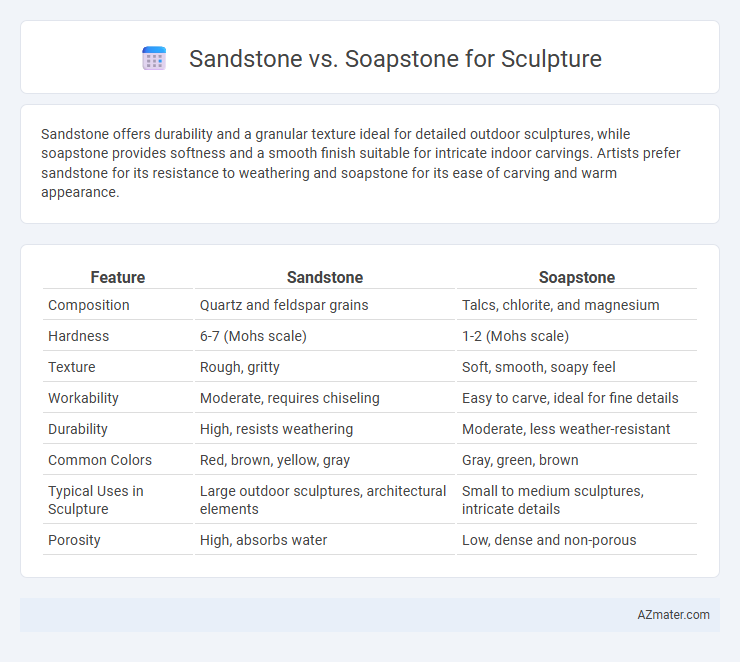Sandstone offers durability and a granular texture ideal for detailed outdoor sculptures, while soapstone provides softness and a smooth finish suitable for intricate indoor carvings. Artists prefer sandstone for its resistance to weathering and soapstone for its ease of carving and warm appearance.
Table of Comparison
| Feature | Sandstone | Soapstone |
|---|---|---|
| Composition | Quartz and feldspar grains | Talcs, chlorite, and magnesium |
| Hardness | 6-7 (Mohs scale) | 1-2 (Mohs scale) |
| Texture | Rough, gritty | Soft, smooth, soapy feel |
| Workability | Moderate, requires chiseling | Easy to carve, ideal for fine details |
| Durability | High, resists weathering | Moderate, less weather-resistant |
| Common Colors | Red, brown, yellow, gray | Gray, green, brown |
| Typical Uses in Sculpture | Large outdoor sculptures, architectural elements | Small to medium sculptures, intricate details |
| Porosity | High, absorbs water | Low, dense and non-porous |
Understanding Sandstone and Soapstone
Sandstone, a sedimentary rock composed mainly of quartz and feldspar, offers a coarse texture and natural grain that enhances detailed sculpting with a warm, earthy color range. Soapstone, a metamorphic rock rich in talc, provides a smooth, soft surface ideal for carving intricate designs and polishing to a high sheen, known for its durability and heat resistance. Understanding the physical properties and workability of sandstone and soapstone is crucial for sculptors to select the right material based on desired texture, carving ease, and final aesthetic.
Geological Origins of Sandstone and Soapstone
Sandstone forms primarily from compacted sand-sized mineral particles, mainly quartz and feldspar, deposited in sedimentary environments like rivers and beaches. Soapstone, or steatite, originates from metamorphic processes transforming talc-rich ultramafic rocks, abundant in regions with high-pressure and low-temperature conditions. The distinct geological origins result in sandstone's granular texture ideal for rough sculpting, while soapstone's dense, soapy feel lends itself to fine, detailed work.
Physical Properties Comparison
Sandstone exhibits a granular texture with low to moderate hardness, typically measuring 6 to 7 on the Mohs scale, making it more susceptible to weathering and erosion compared to soapstone. Soapstone is much softer, rated between 1 and 2 on the Mohs hardness scale, featuring a rich, soapy feel and excellent carving properties due to its talc content. The porosity of sandstone often results in a rougher surface and less durability, while soapstone's dense, non-porous structure provides superior longevity and resistance to heat and acids, ideal for detailed sculpture work.
Workability and Carving Techniques
Sandstone offers a coarse, granular texture that allows for easier rough shaping and chiseling, making it suitable for bold, large-scale sculptures with less intricate details. Soapstone, with its fine-grained, soft composition, provides superior workability for detailed carving, enabling smooth finishes and delicate, precise cuts using simple hand tools. Sculptors often prefer soapstone for intricate designs, while sandstone is chosen for its durability and suitability for outdoor sculptures requiring robust forms.
Durability and Longevity
Sandstone exhibits moderate durability with a grainy texture that can erode over time, making it less ideal for outdoor sculptures exposed to harsh weather. Soapstone, composed primarily of talc, offers superior longevity due to its dense, non-porous nature, resisting moisture, temperature changes, and physical wear. Sculptors prefer soapstone for intricate, enduring works, while sandstone suits projects where natural weathering adds aesthetic value.
Surface Finish and Aesthetic Appeal
Sandstone offers a naturally porous surface with a rough texture that enhances outdoor sculptures through its weather-resistant qualities and warm, earthy tones, making it ideal for rustic and naturalistic designs. Soapstone provides a smoother, softer surface that can be finely polished to a lustrous finish, showcasing rich, muted colors with subtle veining that highlight intricate details and create a more refined and elegant aesthetic. The choice between sandstone and soapstone for sculpture hinges on desired tactile experience and visual impact, with sandstone emphasizing rugged authenticity and soapstone delivering sleek sophistication.
Suitability for Indoor and Outdoor Sculptures
Sandstone's coarse texture and porosity make it suitable for indoor sculptures where protection from weathering is ensured, whereas soapstone's dense, non-porous nature provides superior durability and resistance to outdoor elements, making it ideal for exterior sculptures. Soapstone's softness allows for detailed carving, favored in both indoor and outdoor artistic works, while sandstone's susceptibility to erosion limits its use primarily to sheltered environments. For outdoor sculptures, soapstone's natural resistance to moisture, temperature fluctuations, and pollutants ensures longevity, contrasting with sandstone which may require sealing and regular maintenance.
Cost and Availability
Sandstone is generally more affordable and widely available compared to soapstone, making it a popular choice for budget-conscious sculptors. Soapstone's higher cost is attributed to its softness and ease of carving, but it is less abundant and often sourced from specific regions like Brazil, Canada, and the United States. Availability of sandstone varies regionally but is typically more accessible, providing greater versatility in large-scale or outdoor sculptures.
Popular Uses in Sculpture History
Sandstone and soapstone have played pivotal roles in sculpture history, with sandstone favored for its durability and large-scale architectural carvings in ancient civilizations like Egypt and India. Soapstone's softness and heat resistance made it ideal for detailed, intricate works and small-scale sculptures, commonly used by indigenous cultures and artisans worldwide. Both materials continue to influence modern sculptors due to their unique physical properties and cultural significance.
Choosing the Right Stone for Your Sculpture Project
Sandstone offers a grainy texture ideal for achieving detailed carvings and is abundant and affordable, making it a popular choice for large outdoor sculptures. Soapstone, known for its softness and smooth feel, allows for intricate designs and fine polishing, perfect for smaller indoor sculptures or pieces requiring delicate detail work. Selecting between sandstone and soapstone depends on your project's scale, desired texture, and whether the sculpture will be displayed indoors or outdoors.

Infographic: Sandstone vs Soapstone for Sculpture
 azmater.com
azmater.com